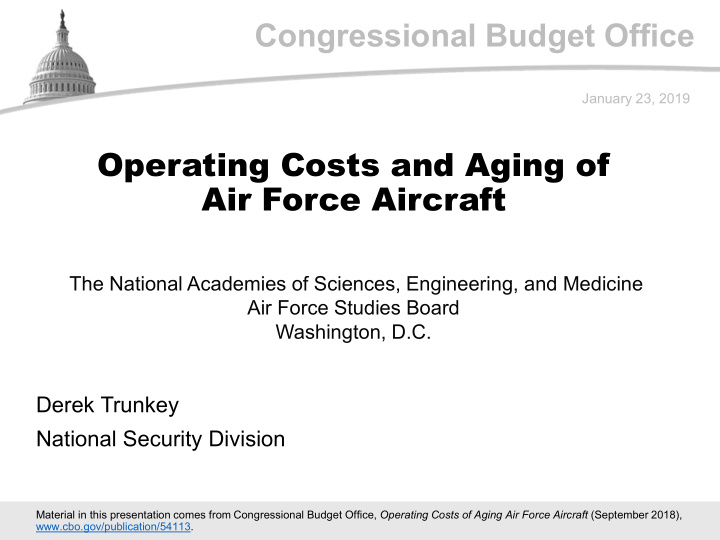



Congressional Budget Office January 23, 2019 Operating Costs and Aging of Air Force Aircraft The National Academies of Sciences, Engineering, and Medicine Air Force Studies Board Washington, D.C. Derek Trunkey National Security Division Material in this presentation comes from Congressional Budget Office, Operating Costs of Aging Air Force Aircraft (September 2018), www.cbo.gov/publication/54113.
CBO Aircraft operating costs are about double acquisition costs and are thought to depend, at least in part, on age. 1
CBO Aircraft Operating Costs Are Expected to Decline Initially, Plateau, and Then Increase During a Final Phase of Their Life Cycle Source: K.R. Sperry and K.E. Burns, Life Cycle Cost Modeling and Simulation to Determine the Economic Service Life of Aging Aircraft (October 2001). 2
CBO Estimates of the operating cost growth associated with age using data from the 1990s found little or no association (0 to 3 percent per year), whereas estimates using data from the 2000s found significant real growth as aircraft age (3 to 8 percent per year). CBO looked to see if there are factors that could explain the higher operating cost growth rates in the recent past. 3
CBO CBO’s Results Explain Divergent Findings From Previous Studies Studies based on 1990s data found little or no operating cost growth associated with age – LMI (2003) found no age effect – CBO (2001) found growth of 1 to 3 percent per year Studies based on 2000s data found larger operating cost growth associated with age – Keating and Arena (2016) found real growth mostly in the 4 to 8 percent per year range – CBO’s current study found real growth mostly in the 3 to 6 percent per year range (based on a similar model with age as the only explanatory variable) See Logistics Management Institute, The Relationship Among Cost, Age, and Usage of Weapon Systems (January 2003); Congressional Budget Office, The Effects of Aging on the Costs of Operating and Maintaining Military Equipment (August 2001), Appendix B, www.cbo.gov/publication/13213; and Edward G. Keating and Mark V. Arena, “Defense Inflation: What Has Happened, Why Has It Happened, and What Can Be Done About It?” Defense and Peace Economics , vol. 27, no. 2 (April 2016), pp. 176–183. 4
CBO CBO’s current study reconciles past studies from different eras by using the size of the Air Force’s budget as an additional explanatory variable. 5
CBO CBO Explored Factors That Could Explain the High Recent Growth in Operating Costs CBO used linear regression models to explain the costs per flying hour The first model used only age of aircraft as an explanatory variable The second model used both age of aircraft and the size of the Air Force’s budget as explanatory variables CBO used annual AFTOC data from 1999 to 2016 for the B-1, B-52, C-5, C-17, C-130, F-15 A-D, F-15E, F-16, F-22A, HH-60G, KC-135, RQ-4, and U-2; most data are from the mature and aging phases of an aircraft’s life cycle 6
CBO The model that did not account for the budget found results comparable to those from prior research that also used data from the 2000s. 7
CBO Illustrating CBO’s Analysis: B-1 Costs per Flying Hour Generally Increased as the System Aged The simple models shows costs rising at about 3 percent per year of age. Source: Congressional Budget Office, using data from the Air Force. 8
CBO Estimates that did not account for the Air Force’s budget show an additional year of age is associated with increases in costs per flying hour, mostly in the range of 3 to 6 percent. 9
CBO Many Air Force Systems Experienced Sizable But Highly Varying Rates of Increase in Costs 10
CBO Some aircraft are still in the immature phase and experienced declining costs. 11
CBO Some Younger Air Force Fleets Experienced Declining Costs per Flying Hour as They Aged 12
CBO The Air Force’s total budget increased significantly between 2000 and 2016. Accounting for that change in budget reduced the association between cost and aircraft age by up to half in the 2000s. 13
CBO The Air Force’s Total Budget Increased Markedly in Real Terms Between 2000 and 2010 14
CBO The model that accounted for the size of the Air Force’s budget found growth rates that were more consistent with those of models based on 1990s data. 15
CBO The B-1 Model That Included the Air Force’s Budget Found a Lower Rate of Growth From Aging The second model decreases the estimated age effect from 3 percent to 2 percent. 16
CBO The model that accounted for the Air Force’s budget found that the association between aging and cost growth was mostly in the 2 to 4 percent range. Other factors (such as mission capable rates and the number of hours flown) had smaller associations or were insignificant. 17
CBO Including the Air Force’s Total Budget Generally Reduced the Estimated Age Effect 18
CBO Additional Information on CBO’s Analytical Approach 19
CBO How CBO Explored Factors That Could Explain the High Recent Growth 1. Measure simple association: 2. Use an enhanced regression accounting for the budget: 3. Examine various aircraft types: – B-1, B-52, C-5, C-17, C-130, F-15 A-D, F-15E, F-16, F-22A, HH-60G, KC-135, RQ-4, and U-2 – Use annual AFTOC data from 1999 to 2016 (most data are from the mature or aging phases of an aircraft’s life cycle) Cost = annual operating cost; FH=flying hours, age = average age, in years; t=year; budget = Air Force Total Obligation Authority. 20
CBO Regression Results for the Simple and Enhanced Models * = p value of less of than 0.1; ** = p value of less than 0.01. The dependent variable is ln(Cost/Flying Hour). 21
Recommend
More recommend